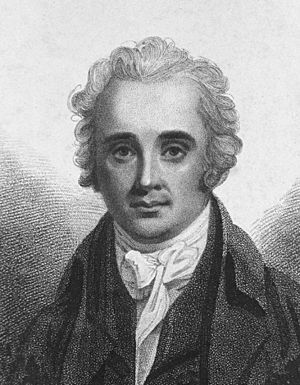Thomas Garnett (physician) facts for kids
Thomas Garnett (born April 21, 1766 – died June 28, 1802) was an English doctor and scientist. He was known for his work in physics, chemistry, and medicine.
Contents
Early Life and Education
Thomas Garnett was born on April 21, 1766, in Casterton, a small village in Westmoreland, England. His family owned some land there. He went to Sedbergh School and, at age fifteen, decided to become a student of John Dawson (surgeon). Dawson was a surgeon and a mathematician in Sedbergh, Yorkshire.
Garnett learned a lot about chemistry and physics from Dawson. In 1785, he began studying at the University of Edinburgh, where he was already known for his great scientific knowledge. He especially loved the lectures given by Dr. Black and Dr. John Brown. He even followed Dr. Brown's medical ideas. It's said that during this time, he hardly socialized and only slept about four hours a day because he was so focused on his studies.
Becoming a Doctor and Writer
In 1788, Thomas Garnett finished his medical degree. He then continued his medical training in London. After a short visit with his parents, he wrote an important article about optics (the study of light) for the Encyclopædia Britannica, a famous encyclopedia.
In 1790, he started working as a doctor in Bradford. The next year, he moved his practice to Knaresborough and Harrogate. He was the first person to scientifically study the waters of Harrogate, which were known for their health benefits. He also came up with several plans to help the people living in Knaresborough.
Lectures and New Opportunities
A wealthy man named Lord Rosslyn built a house for Thomas Garnett in Harrogate. However, Garnett's medical practice there wasn't as successful as he hoped. He even thought about moving to America.
In March 1795, he married Catharine Grace Cleveland, who had been staying at his house. While he was in Liverpool trying to arrange a trip to America, he received an unexpected invitation. He was asked to give lectures on natural philosophy (which included science like physics and chemistry). These lectures were very popular! He repeated them in Manchester and other places.
Professor in Glasgow
Because of his successful lectures, Thomas Garnett was invited to become a professor at Anderson's Institution in Glasgow, Scotland. He did very well there, both as a lecturer and as a doctor. In October 1796, he also gave lectures at the Masonic Lodge in Warrington, Cheshire. He was accepted as a member there, suggesting he became a Freemason while in Scotland.
In 1798, he went on a trip through the highlands of Scotland. He wrote a book about his travels, which was published in 1800. It was a valuable book at the time and still shows how much the area has changed. Later, in 1810, an observatory called Garnethill Observatory was built in Glasgow on land named after him.
Later Life and Legacy
On December 25, 1798, Thomas Garnett's wife died while giving birth to their daughter, Catherine Grace. He was deeply saddened by this loss and never fully recovered.
This sadness made it hard for him to do his job well when he was appointed professor of natural philosophy and chemistry at the Royal Institution in London in October 1799. His lectures were very knowledgeable and clear, but they were too technical for a general audience. Also, his accent from northern England and his poor health made his delivery less lively.
After lecturing for two seasons, he resigned from the Royal Institution. He then started a medical practice in London. He was just beginning to find success when he died on June 28, 1802. He caught typhus fever while working at the Marylebone Dispensary.
After his death, people raised money to publish his Royal Institution lectures. This money helped his two young daughters, one of whom grew up to be the poet Mrs. Catherine Grace Godwin.
Burial and Character
Thomas Garnett was buried in St James's Burial Ground in Euston, London. This area is now near Euston Station. His gravestone and coffin plate were found during an archaeological dig for the new HS2 rail line.
Garnett was known as a very kind man. He was sensitive and cared deeply for others. He was humble about his own abilities but very excited about the discoveries and ideas of other scientists. He wasn't a genius at making new discoveries himself, but he was very observant and smart. In his book about his Highland tour, he even wrote something that sounds a bit like the modern idea that plants might have a kind of intelligence.
Images for kids



